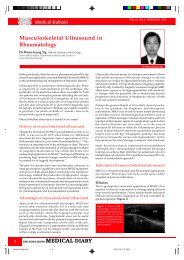MEDICAL DIARY - The Federation of Medical Societies of Hong Kong
MEDICAL DIARY - The Federation of Medical Societies of Hong Kong
MEDICAL DIARY - The Federation of Medical Societies of Hong Kong
Create successful ePaper yourself
Turn your PDF publications into a flip-book with our unique Google optimized e-Paper software.
12<br />
<strong>Medical</strong> Bulletin<br />
resection <strong>of</strong> extensive tumour and reconstruction <strong>of</strong><br />
complicated composite defect that is not possible in the<br />
past. Spearheaded by plastic surgeons and nurtured by<br />
their creative imagination, microvascular free tissue<br />
transfer survived the most skeptical criticism. After<br />
more than 3 decades <strong>of</strong> existence, it is being performed<br />
at an ever-increasing rate for increasingly wider<br />
indications. Its application is no longer limited to<br />
specialised academic centres but available practically in<br />
every plastic and reconstructive surgery centre.<br />
Microvascular free flaps have evolved gradually from<br />
being an extreme procedure <strong>of</strong> last resort to a firstchoice<br />
reconstructive procedure. Improved success<br />
rates, reduced operative time and patient morbidity and<br />
the superior quality <strong>of</strong> the reconstruction help to<br />
popularise this reconstructive method. A prospective<br />
study <strong>of</strong> 493 microvascular free flaps performed by 23<br />
microvascular surgeons over 6 months showed a flap<br />
failure rate <strong>of</strong> 4.1% and a postoperative thrombosis<br />
requiring re-exploration <strong>of</strong> 9.9% 5.<br />
Significant advancement is made with the introduction<br />
<strong>of</strong> perforator flap surgery in reconstructive<br />
microsurgery. <strong>The</strong> muscle, once regarded as essential<br />
to bring blood supply to the more superficial structures<br />
such as the skin and subcutaneous fat could be left in its<br />
native place to maintain its original function. Only the<br />
small perforators that traverse through the muscle are<br />
isolated and it has been shown to be adequate to<br />
support the vascular supply <strong>of</strong> the flap. This not only<br />
minimises the donor site morbidity but also allows a<br />
more refined reconstruction 6.<br />
VOL.12 NO.7 JULY 2007<br />
By virtue <strong>of</strong> the improved technical ability to transfer<br />
tissue, and through a better understanding <strong>of</strong> functional<br />
anatomy, the plastic surgeon can select the most<br />
appropriate part <strong>of</strong> the body as the initial raw material<br />
and with his artistry he can shape that tissue into<br />
graceful anatomic form to restore lost parts or functions 7.<br />
Conclusion<br />
Significant advances are made in the past 3 decades to<br />
make reconstruction <strong>of</strong> complex defects safer, more<br />
reliable and better. <strong>The</strong> quality <strong>of</strong> life <strong>of</strong> these patients with<br />
head and neck cancer is thereby improved. I would like to<br />
take this opportunity to salute all the head and neck<br />
extirpative surgeons and reconstructive microsurgeons<br />
whose commitment to the care <strong>of</strong> the underprivileged<br />
cancer patient population goes mostly unrecognised in<br />
these times <strong>of</strong> diminishing health care resources.<br />
References<br />
1. Yu P, Robb GL. Reconstruction for total and near-total glossectomy<br />
defects.Clin Plast Surg. 2005; 32:411-9.<br />
2. Boyd B, Mulholland S, Gullane P, Irish J, Kelly L, Rotstein L, Brown D.<br />
Reinnervated lateral antebrachial cutaneous neurosome flaps in oral<br />
reconstruction: are we making sense? Plast Reconstr Surg.1994; 93:1350-9.<br />
3. Santamaria E, Wei FC, Chen IH, Chuang DC. Sensation recovery on<br />
innervated radial forearm flap for hemiglossectomy reconstruction by<br />
using different recipient nerves. Plast Reconstr Surg. 1999; 103:450-7<br />
4. Urken ML, Buchbinder D, Weinberg H, Vickery C, Sheiner A, Parker R,<br />
Schaefer J, Som P, Shapiro A, Lawson W, et al. Functional evaluation<br />
following microvascular oromandibular reconstruction <strong>of</strong> the oral cancer<br />
patient: a comparative study <strong>of</strong> reconstructed and nonreconstructed<br />
patients. Laryngoscope 1991; 101:935-50.<br />
5. Khouri RK, Cooley BC, Kunselman AR, Landis JR, Yeramian P, Ingram<br />
D, Natarajan N, Benes CO, Wallemark C. A prospective study <strong>of</strong><br />
microvascular free-flap surgery and outcome.. Plast Reconstr Surg. 1998;<br />
102:711-21.<br />
6. Wei FC, Celik N. Perforator flap entity. Clin Plast Surg. 2003; 30:325-9.<br />
7. Brent B (ed); <strong>The</strong> Artistry <strong>of</strong> Reconstructive Surgery [Preface]. St Louis,<br />
CV Mosby Co, 1987.
















